‘Make Your House like a Temple’: Gender, Space and Domestic Devotion in Medieval Florence
Abstract
1. Introduction
2. The Spaces of Devotion
3. Women’s Space
Predicatrici: ‘Oh ladies, tomorrow I want to make you all preachers.’ Women and devotional instruction.
4. Devotional Texts
5. Devotional Images
6. Conclusions
Funding
Conflicts of Interest
References
- Ajmar-Wollheim, Marta, Flora Dennis, and Ann Matchette. 2006. Approaching the Italian Renaissance Interior: Sources, Methodologies, Debates. Renaissance Studies 20: 623–28. [Google Scholar] [CrossRef]
- Alexandre-Bidon, Danièle. 1998. Une foi en deux ou trois dimensions? Images et objects du faire croire à l’usage des laics. Annales. Histoire, Sciences Sociales 3: 1155–90. [Google Scholar] [CrossRef]
- Anderson, Caroline Corisande. 2007. The Material Culture of Domestic Religion in Early Modern Florence, c.1480-c.1560. Ph.D. thesis, University of York, York, UK. Unpublished. [Google Scholar]
- Angiolini, Enrico. 2006. Lupi, Bonifacio. Dizionario Biografico degli Italiani. p. 66. Available online: http://www.treccani.it/enciclopedia/bonifacio-lupi(Dizionario-Biografico)/ (accessed on 29 January 2020).
- Bailey, Elizabeth. 2009. Raising the Mind to God: The Sensual Journey of Giovanni Morelli (1371-1444) via Devotional Images. Speculum 84: 984–1008. [Google Scholar] [CrossRef]
- Baschet, Jérôme. 2008. L’iconographie médiévale. Paris: Gallimard. [Google Scholar]
- Baxendale, Susannah Foster. 1991. Exile in Practice: The Alberti Family in and out of Florence, 1401–28. Renaissance Quarterly 44: 720–56. [Google Scholar] [CrossRef]
- Bec, Christian. 1984. Les Livres des Florentins (1413–1608). Florence: Olschki. [Google Scholar]
- Benvenuti Papi, A. 1990. ‘In castro poenitentiae’. Figure e modelli femminili nella rappresentazione della santità (sec.XII-XIV). Santità e società femminile nell’Italia medieval. Rome: Herder. [Google Scholar]
- Bernardino da Siena. 1884a. Le prediche volgari di San Bernardino da Siena I. Edited by Luciano Banchi. Siena: Tipografia di San Bernardino. [Google Scholar]
- Bernardino da Siena. 1884b. Le prediche volgari di San Bernardino da Siena II. Edited by Luciano Banchi. Siena: Tipografia di San Bernardino. [Google Scholar]
- Bernardino da Siena. 1888. Le prediche volgari di San Bernardino da Siena III. Edited by Luciano Banchi. Siena: Tipografia di San Bernardino. [Google Scholar]
- Bernardino da Siena. 1935. Prediche Volgare Inedite, 1424-5. Edited by P. Dionisio Pacetti. Siena: Cantagalli. [Google Scholar]
- Biscioni, A. M. 1736. Lettere di santi e beati fiorentini. Florence: Moucke. [Google Scholar]
- Boehm, Barbara Drake, and Laurence Kanter. 1994. Painting and Illumination in Early Renaissance Florence, 1300–1450. New York: New York Metropolitan Museum. [Google Scholar]
- Böninger, Lorenz. 2000. ‘“Altare portatile” e “cappella privata”: Il caso dei Medici’. Mitteilungen des Kunsthistorisches Institut in Florenz 44: 335–37. [Google Scholar]
- Bornstein, Daniel. 1996. Women and Religion in Late Medieval Italy: History and Historiography. In Women and Religion in Medieval and Renaissance Italy. Edited by Daniel Bornstein and Roberto Rusconi. Chicago: University of Chicago Press, pp. 1–27. [Google Scholar]
- Bornstein, Daniel. 1998. Spiritual Kinship and Domestic Devotion. In Gender and Society in Renaissance Italy. Edited by Judith C. Brown and Robert C. Davis. London and New York: Longman, pp. 173–92. [Google Scholar]
- Bourdieu, Pierre. 1971. Genèse et structure du champ religieux. Revue française de sociologie 12: 295–334. [Google Scholar] [CrossRef]
- Brambilla, Simona, ed. 2010. ‘Padre mio dolce.’ Lettere di religiosi a Francesco Datini. Antologia. Rome: Direzione Generale degli Archivi. [Google Scholar]
- Branca, Vittore, ed. 1986. Mercanti Scrittori: Ricordi nella Firenze tra Medioevo e Rinascimento. Milan: Rusconi. [Google Scholar]
- Brundin, Abigail, Deborah Howard, and Mary Laven. 2018. The Sacred Home in Renaissance Italy. Oxford: Oxford University Press. [Google Scholar]
- Bryce, Judith. 2005. Les Livres des Florentines: Reconsidering Women’s Literacy in Quattrocento Florence. In At the Margins: Minority Groups in Premodern Italy. Edited by Stephen J. Milner. Minneapolis: University of Minnesota Press, pp. 133–62. [Google Scholar]
- Bryce, Judith. 2009. Dada degli Adimari’s Letters from Sant’ Antonino. Identity, Maternity, and Spirituality. I Tatti Studies in the Italian Renaissance 12: 11–53. [Google Scholar] [CrossRef]
- Bynum, Caroline Walker. 1987. Holy Feast and Holy Fast: The Religious Significance of Food to Medieval Women. Berkeley: University of California Press. [Google Scholar]
- Bynum, Caroline Walker. 1991. Fragmentation and Redemption: Essays on Gender and the Human Body in Medieval Religion. Cambridge MA and New York: The MIT Press. [Google Scholar]
- Campbell, Erin J., Stephanie R. Miller, and Elizabeth Carroll Consavari, eds. 2013. The Early Modern Italian Domestic Interior, 1400–1700: Objects, Spaces, Domesticities. Farnham: Ashgate. [Google Scholar]
- Casagrande, Giovanna. 1988. Il movimento penitenziale francescana nel dibattito storiografico degli ultimi 25 anni. In Santi e Santità nel movimento penitenziale francescano dal Duecento al Cinquecento. Edited by Lino Temperini. Rome: Analecta TOR. [Google Scholar]
- Cavalca, Domenico. 1837. I frutti della lingua, volgarizzamento del Dialogo di San Gregorio e dell’Epistola di S. Girolamo at Eustochio. Edited by Giovanni Bottari. Milan: Giovanni Silvestri. [Google Scholar]
- Cavalca, Domenico. 1858. Vite dei Santi Padri. Edited by Bartolomeo Sorio and A. Racheli. Trieste: Lloyd Austriaco. [Google Scholar]
- Cavallo, Sandra. 2006. The Artisan’s Casa. In At Home in Renaissance Italy. Edited by Marta Ajmar-Wollheim and Flora Dennis. London: V & A Publications, pp. 66–85. [Google Scholar]
- Cole, Bruce. 1967. The Interior Decoration of the Palazzo Datini in Prato. Mitteilungen des Kunsthistorischen Institutes in Florenz 13: 61–82. [Google Scholar]
- Cooper, Donal. 2011. Access All Areas? Spatial Divides in the Mendicant Churches of Late Medieval Tuscany. In Ritual and Space in the Middle Ages Proceedings of the 2009 Harlaxton Symposium. Edited by Frances Andrews. Donnington: Shaun Tyas, pp. 90–107. [Google Scholar]
- Corbellini, Sabrina. 2019. Creating Domestic Sacred Space: Religious Reading in Late Medieval and Early Modern Italy. In Domestic Devotions in Early Modern Italy. Edited by Maya Corry, Marco Faini and Alessia Meneghin. Leiden and Boston: Brill, pp. 295–305. [Google Scholar]
- Cornish, Alison. 2000. A Lady Asks: The Gender of Vulgarization in Late Medieval Italy. PMLA 115: 166–80. [Google Scholar] [CrossRef]
- Corry, Maya, Deborah Howard, and Mary Laven, eds. 2017. Madonnas & Miracles. The Holy Home in Renaissance Italy. London and New York: Philip Wilson. [Google Scholar]
- Corry, Maya, Marco Faini, and Alessia Meneghin, eds. 2019. Domestic Devotions in Early Modern Italy. Leiden and Boston: Brill. [Google Scholar]
- Cristi, Lucia. 2012. Un illustre e ricco sconsciuto nella Firenze quattrocentesca. In Uomini, Paesaggi, Storie. Studi di Storia Medievale per Giovanni Cherubini II. Edited by Duccio Balestracci. Siena: Salvietti & Barabuffi, pp. 865–75. [Google Scholar]
- Datini, Margherita. 2012. Letters to Francesco Datini. Translated by Carolyn James, and Antonio Pagliaro. Toronto: Iter. [Google Scholar]
- Davis, Robert C. 1998. The Geography of Gender. In Gender and Society in Renaissance Italy. Edited by Judith C. Brown and Robert C. Davis. London and New York: Longman, pp. 19–38. [Google Scholar]
- De Luca, Giuseppe, ed. 1977. Scrittori di religione del Trecento: Volgarizzamenti. 4 vols. Turin: Einaudi. [Google Scholar]
- De Voragine, Jacobus. 1993. The Golden Legend. Edited by William Granger Ryan. 2 vols. Princeton: Princeton University Press. [Google Scholar]
- Delcorno, Carlo, ed. 1975. Giordano da Pisa e l’antica predicazione volgare. Florence: Olsckhi. [Google Scholar]
- Delcorno, Carlo. 1977. Predicazione volgare e volgarizzamenti. Mélanges de l’Ecole Française de Rome, Moyen Age, Temps Modernes 89: 679–89. [Google Scholar] [CrossRef]
- DePrano, Maria. 2018. Art Patronage, Family and Gender in Renaissance Florence: The Tornabuoni. Cambridge: Cambridge University Press. [Google Scholar]
- Dominici, Giovanni. 1860. Regola del Governo di cura Familiare. Edited by Donato Salvi. Florence: Angiolo Garinei. [Google Scholar]
- Dominici, Giovanni. 1889. Il libro d’ amore e di carità del fiorentino. B. Giovanni Dominici dell’ ordine de’ predicatori. Edited by Antonio Ceruti. Bologna: Reale Commissione pe i testi di lingua nelle provincie dell’ Emilia. Collezione d’ Opere. [Google Scholar]
- Flanigan, Theresa. 2014. Art, Memory, and the Cultivation of Virtue: The Ethical Function of Images in Antoninus Opera a ben vivere. Gesta 53: 175–95. [Google Scholar] [CrossRef]
- Freedberg, David. 1989. The Power of Images: Studies in the History and Theory of Response. Chicago: University of Chicago Press. [Google Scholar]
- Fremantle, Richard. 1975. Florentine Gothic Painting from Giotto to Masaccio. London: Secker and Warburg. [Google Scholar]
- Frugoni, Chiara. 1996. Female Mystics, Visions, and Iconography. In Women and Religion in Medieval and Renaissance Italy. Edited by Daniel Bornstein and Roberto Rusconi. Chicago: University of Chicago Press. [Google Scholar]
- Gagliardi, Isabella. 2013. Coscienze e città: la predicazione a Firenze tra la fine del XIII e gli inizi del XV. Considerazioni introduttive. Annali di Storia di Firenze 8: 113–43. [Google Scholar]
- Gilchrist, Roberta. 1999. Gender and Archaeology: Contesting the Past. London: Routledge. [Google Scholar]
- Gilday, Rosi Prieto. 2001. The Women Patrons of Neri di Bicci. In Beyond Isabella: Secular Women Patrons of Art in Renaissance Italy. Edited by Sheryl G. Reiss and David G. Wilkiins. Kirksville: Truman State University Press, pp. 51–75. [Google Scholar]
- Gill, Katherine. 1994. Women and the Production of Religious Literature in the Vernacular, 1300–1500. In Creative Women in Medieval and Early Modern Italy: A Religious and Artistic Renaissance. Edited by E. Ann Matter and John Coakley. Philadelphia: University of Pennsylvania Press, pp. 64–104. [Google Scholar]
- Gombrich, E. H. 1966. The Early Medici as Patrons of Art. In Norm and Form. London: Phaidon, pp. 35–70. [Google Scholar]
- Green, Rosalie, and Isa Ragusa, eds. 1961. Meditations on the Life of Christ. Princeton: Princeton University Press. [Google Scholar]
- Grundmann, Herbert. 1995. Religious Movements in the Middle Ages. Translated by Steven Rowan. Notre Dame: University of Notre Dame Press. [Google Scholar]
- Heller, Ena Giurescu. 2005. Access to Salvation: The Place (and Space) of Women Patrons in Fourteenth-Century Florence. In Women’s Space: Patronage, Place, and Gender in the Medieval Church. Edited by Virginia Chieffo Raguin and Sarah Stanbury. New York: State University of New York Press, pp. 161–83. [Google Scholar]
- Holly, Flora. 2009. The Devout Belief of Imagination. Turnhout: Brepols. [Google Scholar]
- Kaborycha, Lisa. 2012. Brigida Baldinotti and Her Two Epistles n Quattrocento Florentine Manuscripts. Speculum 87: 793–826. [Google Scholar] [CrossRef]
- Kent, Dale. 2000. Cosimo de’ Medici and the Florentine Renaissance. London and New Haven: Yale University Press. [Google Scholar]
- Lami, Giovanni. 1758. Sanctae Ecclesiae Florentinae Monumenta I. Florence: Ex Typographio Deiparae ab Angelo Salutatae. [Google Scholar]
- Landucci, Luca. 1883. Diario Fiorentino dal 1450 al 1516. Edited by Iodoco del Badia. Florence: Sansoni. [Google Scholar]
- Laufenberg, Lynn Marie. 2009. The Long Arm of the Florentine Law. Two Texts (1343, 1345). In Medieval Italy: Texts in Translation. Edited by Katherine Ludwig Jansen, Joanna Drell and Frances Andrews. Philadelphia: University of Pennsylvania Press, pp. 199–200. [Google Scholar]
- Lawless, Catherine. 2010. The Virgin’s Grandmother. Journal of Medieval History 36: 379–93. [Google Scholar] [CrossRef]
- Lawless, Catherine. 2011. Representation, Religion, Gender and Space. In Ritual and Space in the Middle Ages: Proceedings of the 2009 Harlaxton Symposium. Edited by Frances Andrews. Donnington: Shaun Tyas, pp. 232–58. [Google Scholar]
- Lawless, Catherine. 2014–2015. Sensing the Image: Gender, Piety and Images in Late Medieval Europe. Touch Me, Touch Me Not. Open Arts Journal 4: 41–60. Available online: https://openartsjournal.org/issue-4/ (accessed on 9 April 2019).
- Lefebvre, Henri. 1991. The Production of Space. Oxford: Blackwell. [Google Scholar]
- Lydecker, John Kent. 1987. The Domestic Setting of the Arts in Renaissance Florence. Baltimore: The Johns Hopkins University Press. [Google Scholar]
- Mâle, Emil. 1986. Religious Art in France: The Late Middle Ages: A Study in Iconography and its Sources. Edited by Harry Bober. Translated by Marthiel Mathews. Princeton: Princeton University Press. [Google Scholar]
- Matter, E. Ann. 1999. Mystic Marriage. In Women and Faith: Catholic Religious Life in Italy from Late Antiquity to the Present. Edited by Lucetta Scaraffia and Gabriella Zarri. Cambridge: Harvard University Press, pp. 31–41. [Google Scholar]
- Mazzatinti, Giuseppe. 1901. Inventari dei Manoscritti delle Biblioteche d’ Italia. Forli: Bordandini, vol. XI. [Google Scholar]
- Mazzei, Lapo. 1880. Lettere di un Notaro a un Mercatante del Secolo XIV, con altre Lettere e Documenti. 2 vols. Edited by Cesare Guasti. Florence: Le Monnier. [Google Scholar]
- McNamer, Sarah. 2009. The Origins of the Meditationes Vitae Christi. Speculum 84: 905–55. [Google Scholar] [CrossRef]
- Miglio, Luisa. 2008. Governare l’alfabeto: Donne, scrittura e libri nel Medioevo. Rome: Viella. [Google Scholar]
- Morçay, Raoul. 1914. Saint Antonin. Fondateur du Couvent de Saint-Marc. Tours and Paris: Maison A. Mame et Fils; Libraire Gabalda. [Google Scholar]
- Moreni, Domenico. 1831. Prediche del B. Giordano da Rivalto recitate in Firenze dal MCCCIII al MCCCVI. 2 vols. Florence: Marghera. [Google Scholar]
- Morpurgo, Solomone. 1887. Catalogo dei Manoscritti Panciatichiani Della Biblioteca Nazionale Centrale di Firenze. Rome: Istituto Poligrafico dello Stato, vol. I. [Google Scholar]
- Morse, Margaret A. 2007. Creating Sacred Space: The Religious Visual Culture of the Renaissance Venetian Casa. Renaissance Studies 21: 151–84. [Google Scholar] [CrossRef]
- Musacchio, Jacqueline Marie. 1997. Imaginative Conceptions in Renaissance Italy. In Picturing Women in Renaissance and Baroque Italy. Edited by Geraldine A. Johnson and Sara F. Mathews Grieco. Cambridge: Cambridge University Press, pp. 42–60. [Google Scholar]
- Musacchio, Jacqueline Marie. 1999. The Art and Ritual of Childbirth in Renaissance Italy. New Haven and London: Yale University Press. [Google Scholar]
- Musacchio, Jacqueline Marie. 2008. Art, Marriage and Family in the Florentine Renaissance. New Haven and London: Yale University Press. [Google Scholar]
- Neri di Bicci. 1976. Le Ricordanze. Edited by Bruno Santi. Pisa: Edizioni Marlin. [Google Scholar]
- Paoli, Maria Pia. S. Antonino ‘vere pastor ac bonus pastor’: Storia e mito di un modello. In Verso Savonarola. Misticismo, profezia, empiti riformistici fra Medioevo et Età moderna. Edited by G. Garfagnini and O. Picone. Florence: Sismel. Available online: https://www.storiadifirenze.org/?biblioteca=s-antonino-vere-pastor-ac-bonus-pastor-storia-e-mito-di-un-modello (accessed on 9 April 2019).
- Paolo da Certaldo. 1945. Il Libro di Buoni Costumi. Edited by A. Schiaffoni. Florence: Le Monnier. [Google Scholar]
- Passerini, Luigi. 1876. Genealogia e Storia della Famiglia Ginori. Florence: M. Cellini. [Google Scholar]
- Petrucci, A. 1984. Lire au Moyen Âge. Mélanges de l’Ecole française de Rome. Moyen-Age, Temps modernes 96: 603–13. [Google Scholar]
- Pierozzi, Antonino. 1858. Opere a ben vivere di Santo Antonino. Edited by Francesco Palermo. Florence: M. Cellini. [Google Scholar]
- Randolph, Adrian. 1997. Regarding Women in Sacred Space. In Picturing Women in Renaissance and Baroque Italy. Edited by Geraldine A. Johnson and Sara F. Matthews Grieco. Cambridge: Cambridge University Press, pp. 17–41. [Google Scholar]
- Rigaux, Dominique. 1996. Un image pour la route. L’iconographie de saint Christophe dans les régions alpines (XIIe-XVe siècle. In in Voyages et voyageurs au Moyen Age. Actes des congrès de la Société des historiens médiévistes de l’enseignement supérieur public, 26e congrès. Aubazine 1996: 235–66. [Google Scholar]
- Romagnoli, Alessandra Bartolomei. 2016. La Vita Religiosa Femminile alla Fine del Medio Evo: Temi e Problemi. In Litterae ex quibus nomen Dei componitur. Studi per l’ottantesimo compleanno di Giuseppe Avarucci. Biblioteca Seraphico-Capuccina, 104. Rome: Istituto Storico dei Cappucini, pp. 291–305. [Google Scholar]
- Ross, Janet. 1911. The Lives of the Early Medici As Told in Their Letters. Boston: Richard G. Badger, The Gorham Press. [Google Scholar]
- Rusconi, Roberto. 1981. De la prédication à la confession: Transmission et contrôle de modèles de comportement au XIII siècle. In Modalité de la diffusion et de la réception des messages religieux du XII au XV siècle. Actes de table ronde de Rome (22–23 juin 1979). Rome: École française de Rome, pp. 67–85. [Google Scholar]
- Sacchetti, Franco. 1857. I sermoni evangelici, le lettere ed altri scritti inediti o rari. Edited by O. Gigli. Florence: Le Monnier. [Google Scholar]
- Savonarola, Girolamo. 1845. Prediche di Fra Girolamo Savonarola de’ Predicatori. Florence: Alcide Parenti. [Google Scholar]
- Schmidt, Victor M. 2001. Painting and Individual Devotion in Late Medieval Italy: The Case of Saint Catherine of Alexandria. In Visions of Holiness: Art and Devotion in Renaissance Italy. Edited by Andrew Ladis and Shelley E. Zuraw. Athens: University of Georgia, pp. 21–36. [Google Scholar]
- Schmidt, Victor M. 2005. Painted Piety. Panel Paintings for Personal Devotion in Tuscany, 1250–1400. Florence: Centro Di. [Google Scholar]
- Schuchman, Anne M. 2009. The Life of Umiliana de’ Cerchi (1246). In Medieval Italy: A Documentary History. Edited by Kate Jansen, Joanna Drell and Frances Andrews. University Park: Pennsylvania University Press, pp. 377–84. [Google Scholar]
- Thomas, Anabel. 1995. The Painter’s Practice in Renaissance Tuscany. Cambridge: Cambridge University Press. [Google Scholar]
- Vauchez, André. 1990. Ordini Mendicanti e Societa Italiana XIII-XV secolo. Milan: Arnoldo Mondadori. [Google Scholar]
- Vauchez, André. 1993. Comparsa e affermazione di una religiosità laica (XII secolo–inizio XIV secolo). In Storia dell’Italia Religiosa: 1. L’Antichità e il Medioevo. Edited by G. De Rosa, T. Gregory and A. Vauchez. Bari: Laterza, pp. 397–425. [Google Scholar]
- Velluti, Donato. 1914. Cronica Domestica. Edited by Isidoro del Lungo and Guglielmo Volpi. Florence: G. C. Sansoni. [Google Scholar]
- Von Moos, Peter. 1996. Occulta cordis. Contrôle de soi et confession au Moyen Âge, II. Formes de la confession. Médiévales 30: 117–37. [Google Scholar] [CrossRef]
- Walsh, Christine. 2007. The Cult of St Katherine of Alexandria in Early Medieval Europe. Aldershot: Ashgate. [Google Scholar]
- Webb, Diana M. 1990. Woman and Home: The Domestic Setting of Late Medieval Spirituality. Studies in Church History 27: 159–73. [Google Scholar] [CrossRef]
- Wieck, Roger. 1997. Painted Prayers: The Book of Hours in Medieval and Renaissance Art. New York: George Braziller. [Google Scholar]
- Wilkins, David G. 2002. Opening the Doors to Devotion: Trecento Triptychs and Suggestions concerning Images and Domestic Practice in Florence. In Italian Panel Painting of the Duecento and Trecento. Edited by Victor M. Schmidt. Washington and New Haven: Yale University Press, pp. 371–93. [Google Scholar]
| 1 | ’Però che debbi sapere sono permesse e ordinate le dipinture degli Angeli e Santi, per utilità mentale de’ più bassi’. |
| 2 | ‘E se non vuogli, o non puoi, di tante dipinture fare quasi tempio in casa, avendo balia fa’ sieno menati spesso in chiesa a tempo non vi sia tumulto, nè vi si dica ufficcio; acciò nè lor mente sia rapita dalla tumultuata gente, nè lor cianciare dia impaccio al divino ufficio.’ |
| 3 | ‘Ma farai uno altaruzzo o due in casa, sotto titolo del Salvatore, del quale è la festa ogni domenica: abbivi tre o quattro dossaluzzi variati, ed egli, o più, ne sieno sacrestani; mostrando loro come ogni festa debbano variatamente adornare quella cappelluzza. Alcuna volta saranno occupati in fare grillande di fiori o d’erbe, e incoronare Iesu, adornare la Vergine Maria dipinta, fare candeluzze, accendere e spegnere, incensare, tenere pulito, spazzare, parare gli altari, comporre de’ candelieri di fuscelli di cera, di terra; sievi la campanuzzi, corrino a sonare tutte l’ore co me sentono nelle chiese, possansi parare con le camice come accoliti, cantinvi come sanno, parinsi a dir messa, e sieno menato alcuni volta alla ch iesa e loro mostrato quel che fanno e’ veri sacerdoti acciò imparino a contraffargli; e così variatamente quanto di può sieno occupati con amore circa il divino santuario, lasciandogli guastare le frascoline loro faranno, acciò abbin bisogno di rifarle.’ |
| 4 | ‘La quale fu piccola e non bella; ma savia, buona, piacevole, amorevole, costumata, e d’ogni vertù piena e perfetta, e la quale si facea amare e volere bene a ogni persona: e io molto me n’ò lodare, chè me amava e disiderava con tutto quore. Era bonissima dell’anima sua: ed è da credere, che Nostro Signore Iesù Cristo l’abbia ricevuta nelle sue braccia, faccendo buone e ottime operazioni, limosiniera, e d’orare e visitare la chiesa, e avendo avuto, nella sua infermità, perdono di colpa e pena dal vescovo Agustino Tinacci.’ |
| 5 | ‘O donne, domain vi voglio fare tutte predicatrici.’ |
| 6 | ‘Insegna loro predicare poi hanno veduto alcuna volta predicare in ch iesa, e tu predicherai a quegli dicendo cose non nocive e di sollazzo, e poi facendoli predicare stando tu con la tua famiglia a sedere basso quando in alto dicono, non ridendo ma commendando, e premiando quando ha contraffatto l’ufficio spirituale.’ |
| 7 | ‘Ècci chi abbia lo infermo in casa? – Sì. – Non cognosci tu quanto bene fa il governo suo? Non l’abandonare per venire alla predica. Hai figliuoli? – Sì. – Non gli abandonare di quello che hanno bisogno, per venire alla predica. Hai il marito e’ figliuoli, i quali bisogna che sieno governati di quello che bisogna alla famiglia? – Sì. – Fa’, fa’ che non gli lassi per venire alla predica; fa’ che tu prima governi la casa di quelle cosec he bisognano, e poi viene alla predica [...]’ |
| 8 | ‘E perchè io ho insegnato come debbano règgiare gli uomini il palazzo e la città; così anco voglio insegnare alle donne quello che debbano fare alle case loro.’ |
| 9 | ‘E se di queste due cose tu non potessi fare altro che l’una, o udire la messa o udire la predica, tu debbi piuttosto lassare la mess ache la pedica; imperò chè la ragione ci è espressa, che non è tanto pericolo dell’anima tua a non udire la messa, quanto è a non udire la predica.’ |
| 10 | ‘Dèbbesi a’ fanciulli insegnare l’Ave Maria, il Pater noster, il Credo in Deum, che ogni cristiano è tenuto di saperlo; e che a l’uscita di casa si segni del segno della santa croce. E così quando si leva del letto e quando si corica; e che dica cinque Pater nostri e cinque Ave Marie quando si va a letto, e quando si lieva la Salve Regina, e dell’altre orazioni…E tutte le dette cose debbe loro insegnare la madre. Il padre: l’udire della messa, le prediche, il vespro, le laulde, insegnarli orare, confessare, e che si guardi da ma’ contratti, e che non giuochi, e che non esca di casa la notte con bullettini o sanza. Ammunirlo che si guardi dalle taverne, dalle ghiottornie, e che digiuni e dì comandati, e che si guardi dalle cattive compagnie e dalle male usanze.’ |
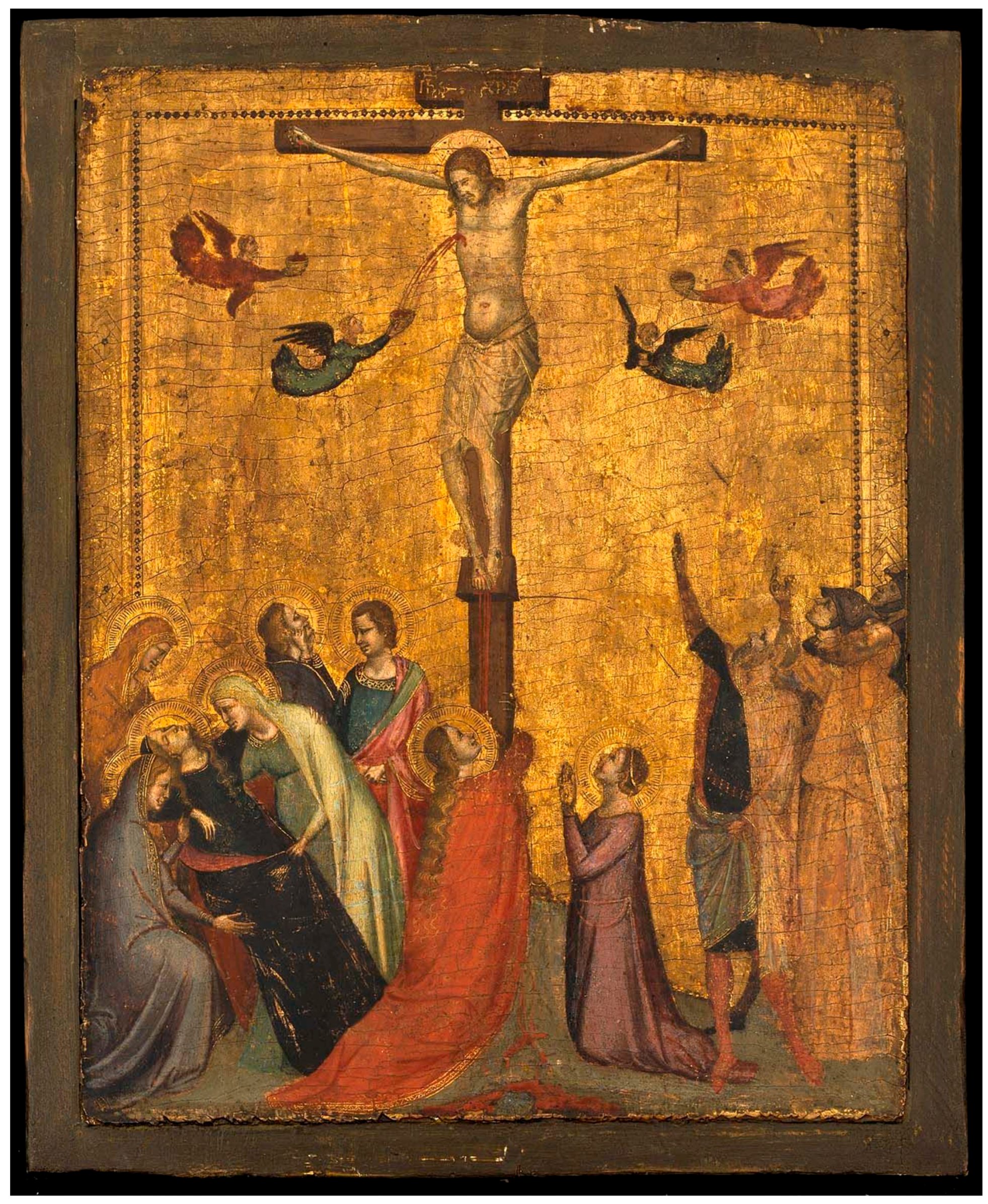
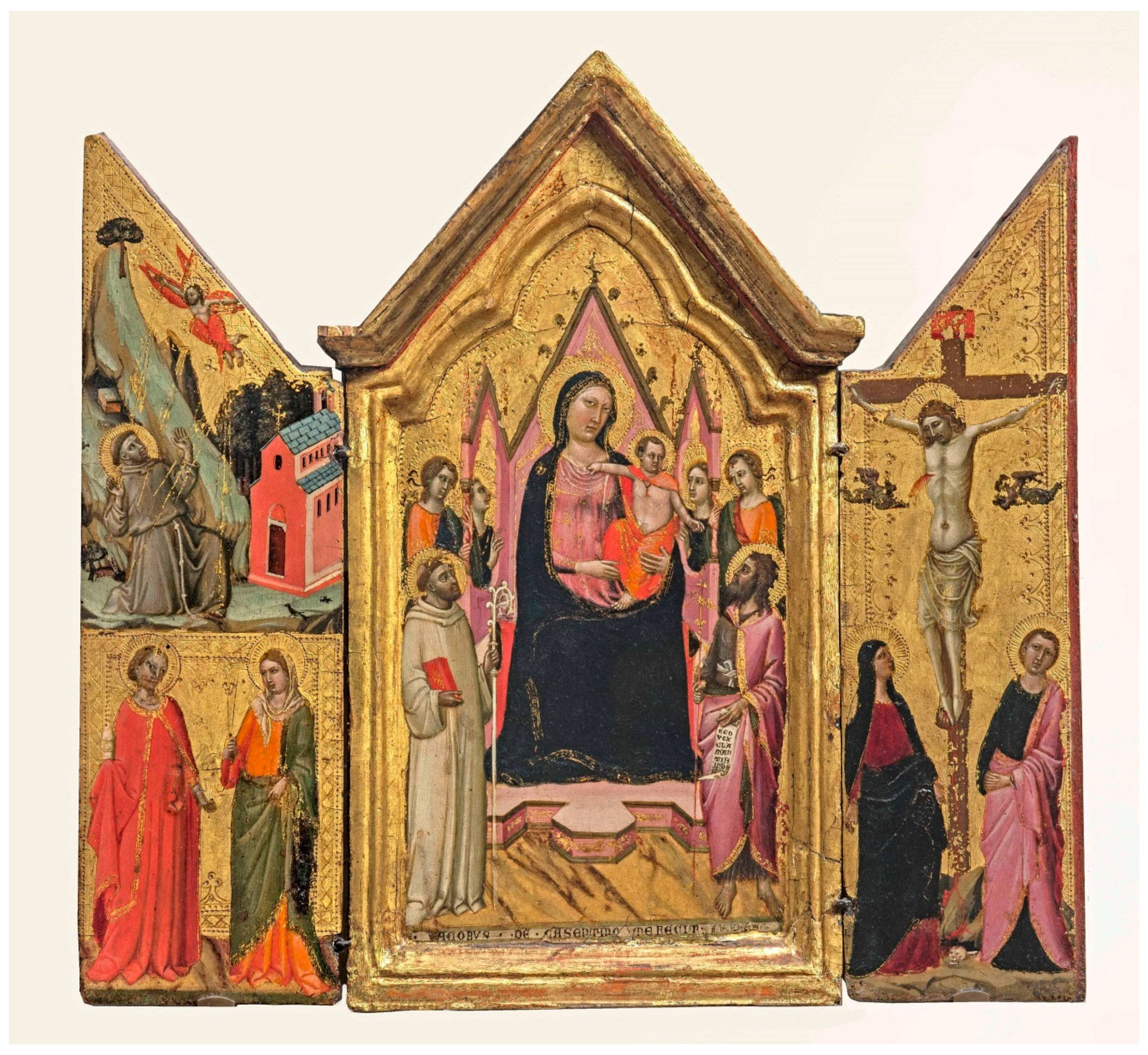
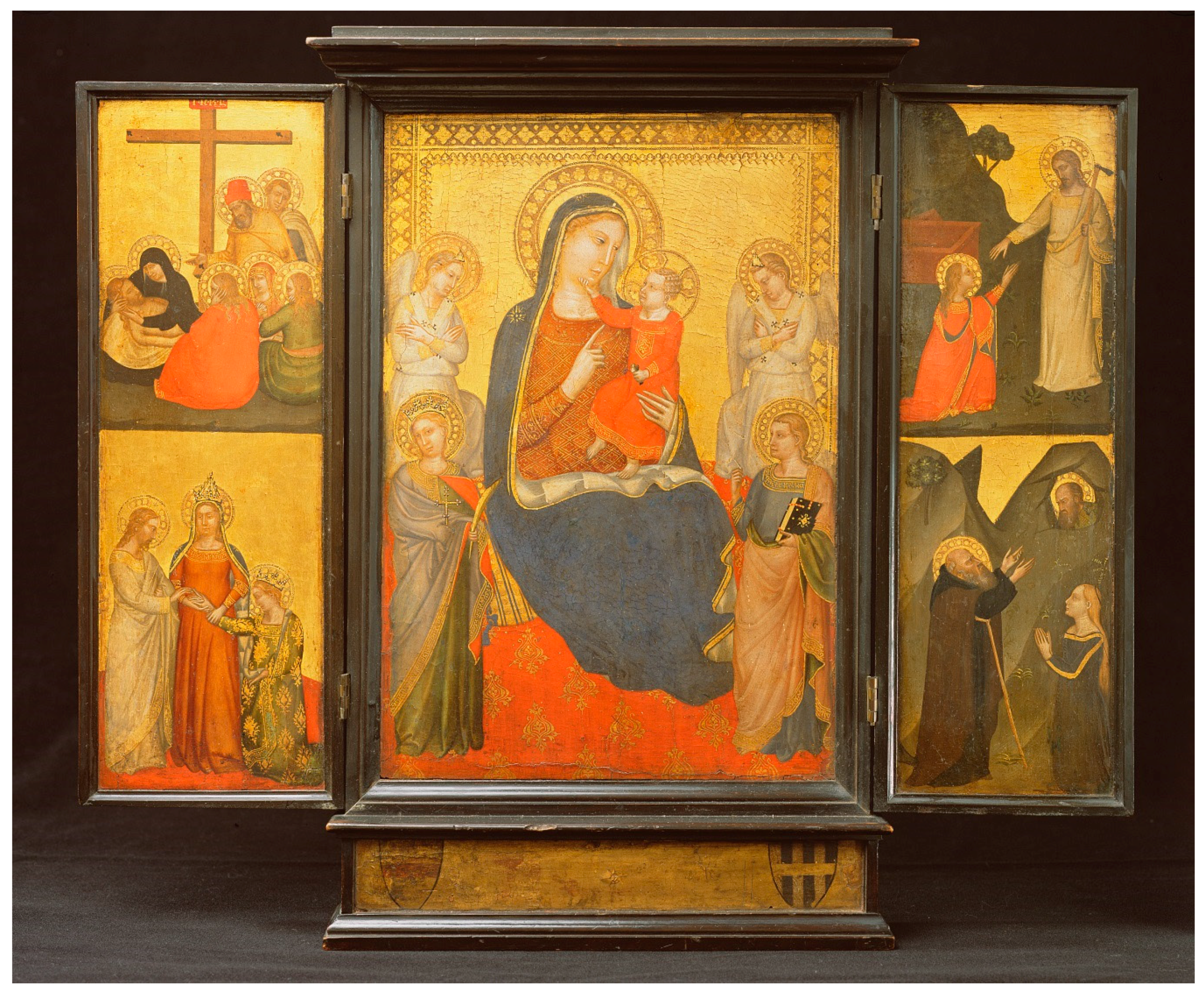
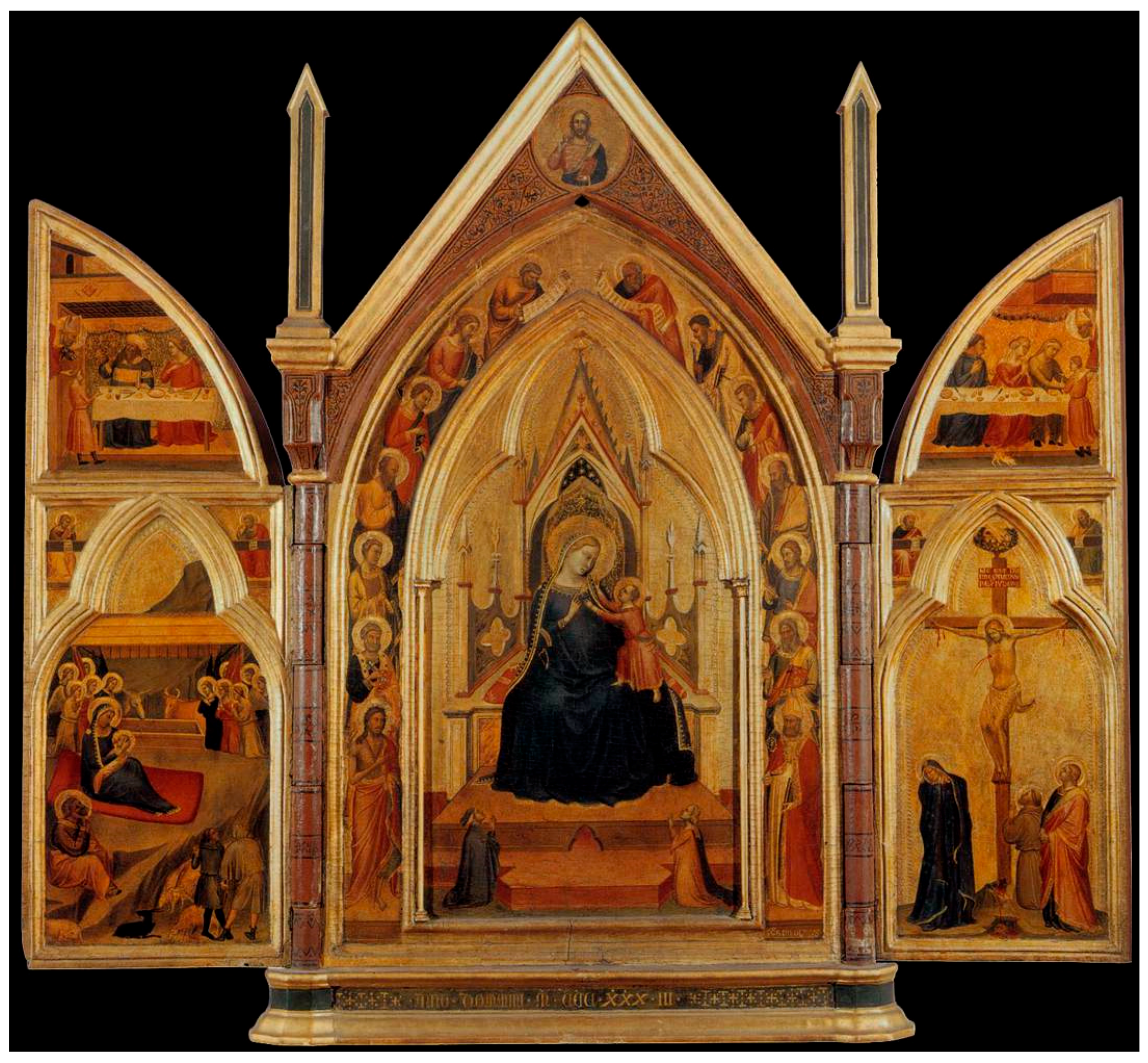
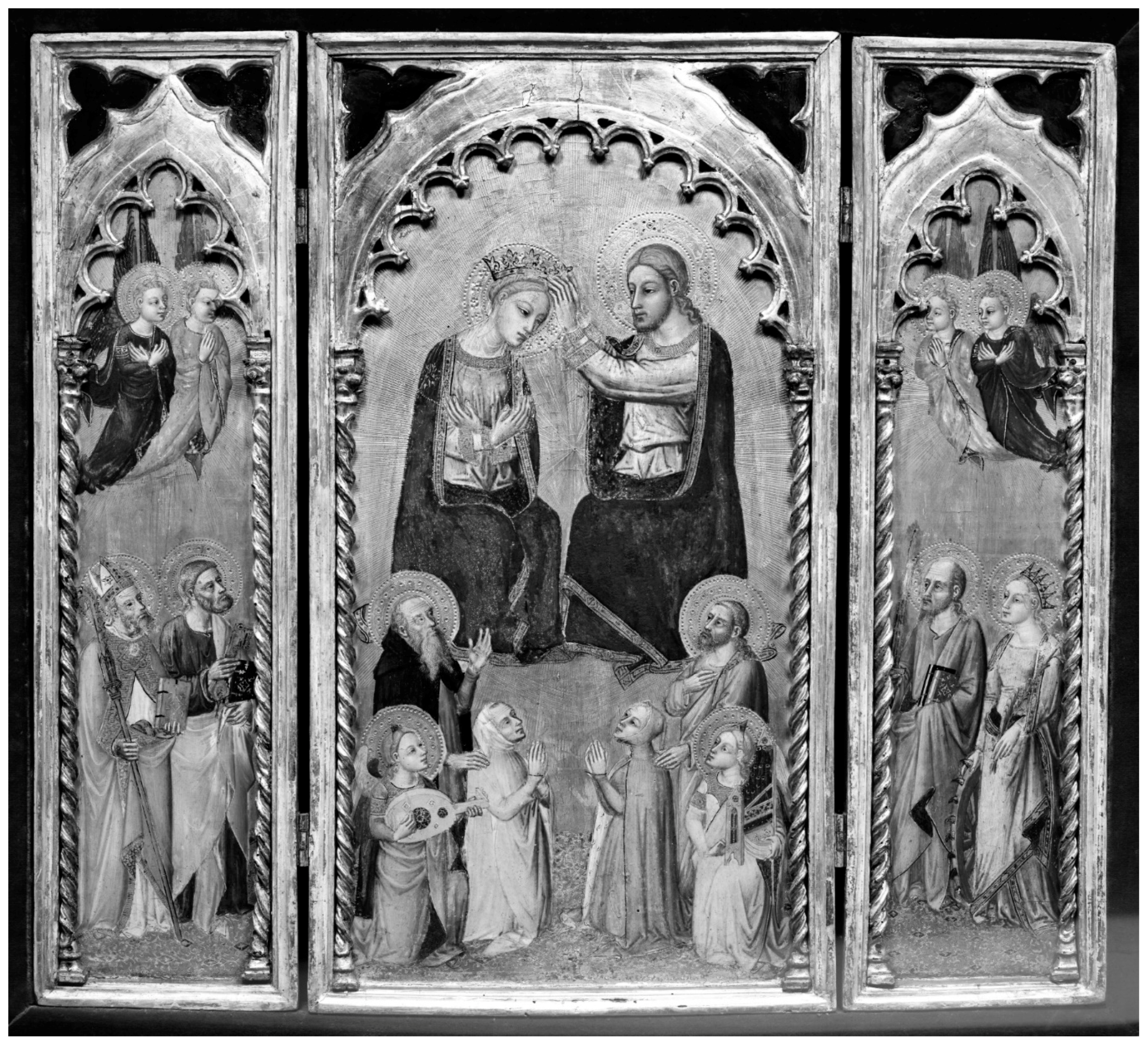
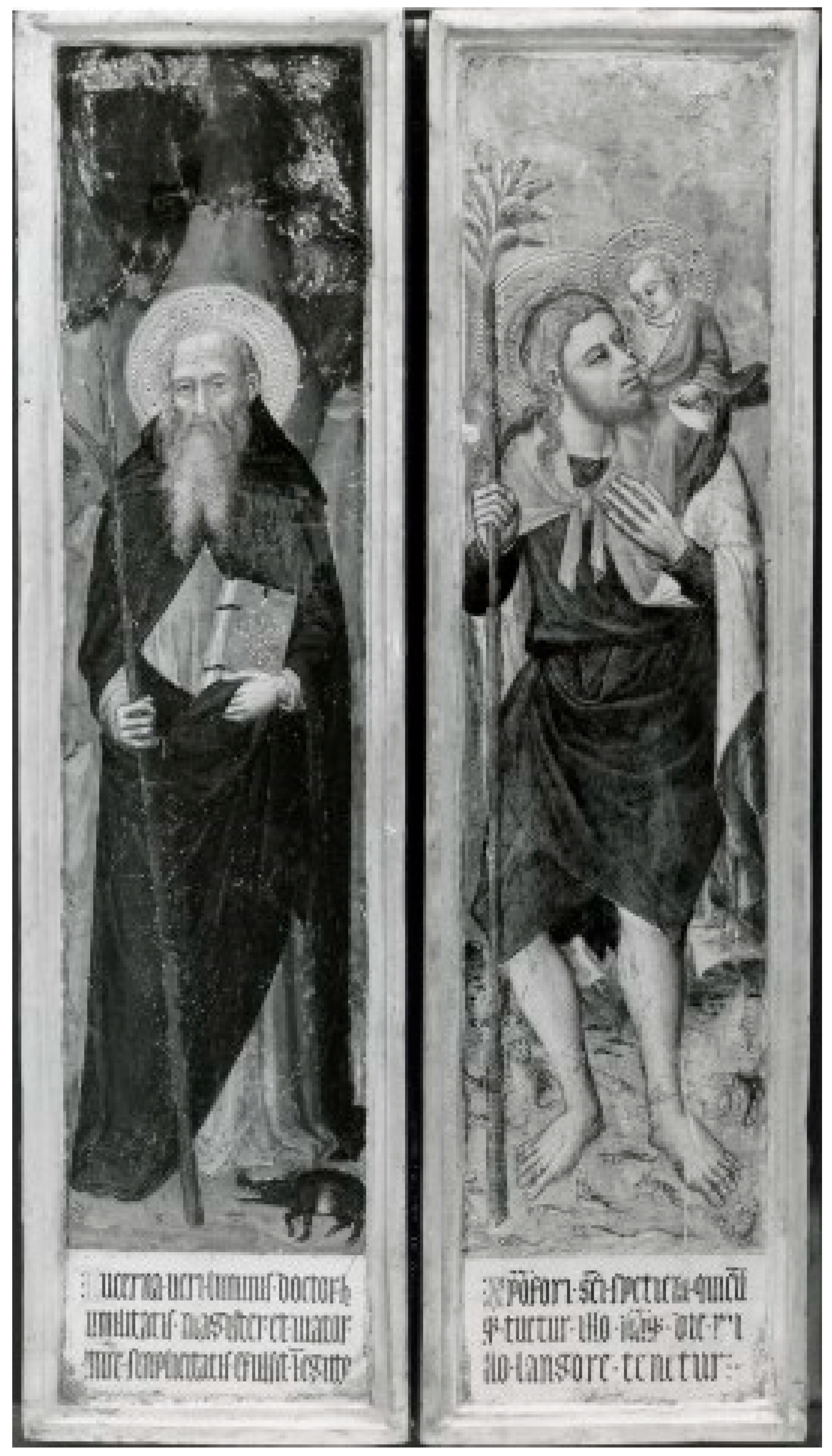
© 2020 by the author. Licensee MDPI, Basel, Switzerland. This article is an open access article distributed under the terms and conditions of the Creative Commons Attribution (CC BY) license (http://creativecommons.org/licenses/by/4.0/).
Share and Cite
Lawless, C. ‘Make Your House like a Temple’: Gender, Space and Domestic Devotion in Medieval Florence. Religions 2020, 11, 120. https://doi.org/10.3390/rel11030120
Lawless C. ‘Make Your House like a Temple’: Gender, Space and Domestic Devotion in Medieval Florence. Religions. 2020; 11(3):120. https://doi.org/10.3390/rel11030120
Chicago/Turabian StyleLawless, Catherine. 2020. "‘Make Your House like a Temple’: Gender, Space and Domestic Devotion in Medieval Florence" Religions 11, no. 3: 120. https://doi.org/10.3390/rel11030120
APA StyleLawless, C. (2020). ‘Make Your House like a Temple’: Gender, Space and Domestic Devotion in Medieval Florence. Religions, 11(3), 120. https://doi.org/10.3390/rel11030120



